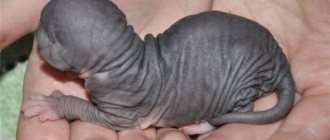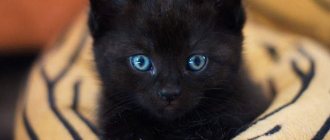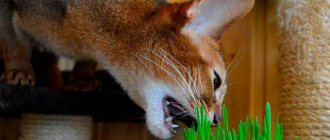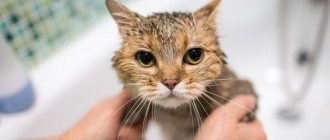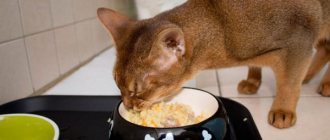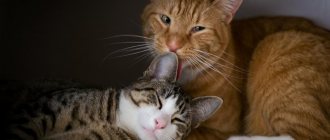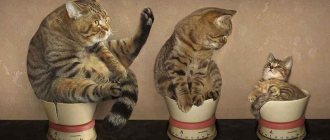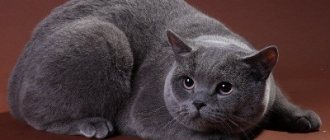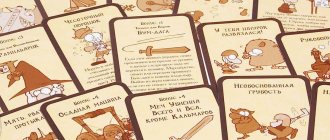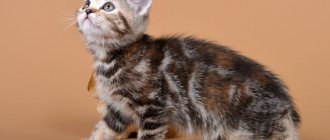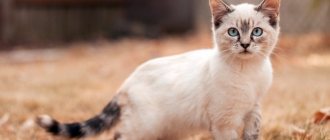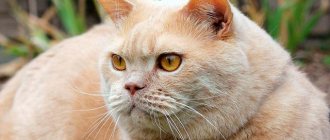How old do cats grow?
Height in cats is a relative concept. With age, they may become larger in both length and width, depending on the breed. And not only this affects the growth rate of a pet. Physical activity, diet, and general health all play a role here. Of course, there are average indicators that can be used to roughly determine at what age a pet will reach its maximum size. But they are different for each breed.
Scots
Among the Scots, one can distinguish lop-eared and straight-eared representatives. If we look at the general characteristics of the breed, we can see that by the age of three, cats’ muscle mass, skeleton, as well as eye color and coat color are finally formed.
Fold
Scottish Fold kittens are born weighing from 60 to 140 grams. It all depends on the number of brothers and sisters. In the first two weeks, the weight gain will be small and will not exceed 20 grams. In the future, growth will go faster, the main thing is to ensure that the kitten receives a sufficient amount of mother's milk. By two months, his weight should reach 1.5 kg, and by six months, up to 3 kg.
Scottish Folds develop to their maximum by the age of three. The weight of an adult male can reach 6.5 kg, and females 4.5 kg. By that time, they are already fully physically developed and ready to reproduce.
Straight-eared
Representatives of straight-eared Scots are somewhat larger than their fold-eared counterparts. Their growth rates are not much different, but their final weight is yes. Males by the time of their final development reach 7 kg in weight, while females can weigh 6 kg. This is due not only to nutrition. Genetics plays a big role here. Straight-eared Scots rarely have deviations in terms of height. And if the cat is also a purebred, then we can safely say that he will grow into a fat teddy.
British
The British begin to actively grow already at the age of one month. By then, their teeth have formed and they can eat on their own. Since, due to the characteristics of the breed, these felines are prone to obesity, their diet should be given increased attention.
Their musculoskeletal mass is finally formed by 2-2.5 years of life. But even after this they can continue to develop, until they reach the age of three. The weight of an adult male can reach 8 kg, and a female 6 kg. If you add two kilograms to each indicator, you can get the weight that these representatives of the feline family can gain after castration or sterilization.
Regular cats
Cats and male cats without claims to purebred also have their own developmental characteristics. As a rule, they reach the bulk and growth by two years. As mentioned earlier, a lot depends on heredity, nutrition and lifestyle. Sedentary animals that prefer to spend most of their time lying on the sofa can reach a weight of up to 9 kg. Moreover, these can be both males and females. Especially when it comes to castrated or sterilized cats.
In the latter case, special attention must be paid to nutrition. It will be better if you feed the animal with special dietary foods that have a balanced combination of nutritional components and are easily absorbed by the body.
Maine Coon
There is a misconception that adult Maine Coons can reach up to 15 and even 25 kg in weight. However, despite the large growth (up to 100 cm in length) of the animal, the weight of an adult male does not exceed 12 kg, and the female is even less - 8 kg. They are born larger than kittens of other breeds: babies can weigh from 120 to 140 grams. And this only happens if there are several kittens in the litter. If the baby was born alone, his weight may be 160 grams.
Maine Coons grow up to three years old, like most purebred cats. Closer to this age, their muscles actively develop: their chest becomes wider, and their shoulders and paws become stronger.
Bengal
Bengal babies weigh from 70 to 120 grams at birth. They grow actively until 9 months, after which the rate of their development decreases. In females at this age it can generally stop, while males can grow up to two years.
The maximum weight of females does not exceed 5 kg, males - 8 kg. And the body length can vary from 50 cm to 1 meter.
Sphinxes
Sphynx kittens are born tiny and helpless. Their birth weight is only 85 grams. But at the same time, after three days they are able to independently find their mother’s nipple and, with the movement of their paws, cause the release of milk. Sphynx cats are considered one of the smartest cats.
British kitten weight table by month
The weight of a British cat, as can be seen from the table, changes unevenly with age: the animal’s muscle and fat mass grows most rapidly in the first month, then slows down. At one year of age, the British pet actually reaches its maximum weight, and the weight stabilizes at 2.5 years.
| age | female, kg | male, kg | peculiarities |
| newborn | 0,07–0,15 | 0,08–0,15 | newborn kittens of the British breed are quite large |
| first week | 0,1–0,25 | 0,25–0,3 | a nursing cat needs to be well fed, food must be rich in vitamins and balanced, so that the cubs develop fully |
| second | 0,15–0,35 | 0,35–0,4 | by this time, British kittens should weigh approximately 1.5 times more than at birth, the eyelids of large and developed cubs open |
| third | 0,2–0,4 | 0,4–0,65 | you can gradually introduce complementary foods, especially if the litter is large and the kittens are weak |
| first month of life | 0,25–0,6 | 0,55–0,7 | as complementary food, they give boiled beef or chicken minced in a meat grinder or blender, sea fish fillet, soft canned cat food, cottage cheese, boiled yolk |
| 2 months | 0,45–0,9 | 1–1,7 | |
| 3 | 1–1,5 | 1,5–2,5 | if the cubs are still fed with mother's milk, then the feeding should be more balanced and rich in vitamins |
| 4 | 1,8–2,4 | 2,2–3,9 | |
| 5 | 2,2–2,9 | 2,6–4,3 | Before becoming an adult, a British kitten must gain the same number of kilograms as at 5 months of age |
| 6 | 2,3–3,6 | 3–5,4 | |
| 7 | 2,4–3,8 | 3,3–5,6 | |
| 8 | 2,5–4 | 3,5–6 | |
| 9 | 2,5–4,2 | 3,8–6,4 | |
| 10 | 2,5–4,3 | 4,1–6,6 | |
| 11 | 2,5–4,3 | 4,2–6,7 | |
| year | 2,5–4,5 | 4,5–7 | Once a British cat has become mature, it is prohibited to give fatty meats, smoked meats, fatty dairy products, river fish (they may contain helminths), bones (they are poorly digested in the stomach) |
To what age do domestic cats and cats of different breeds grow?
The size and physiological maturation of animals depend on a large number of different factors. To know exactly to what age cats grow, it is necessary to take into account their breed, the functioning of the endocrine glands and their general health. Proper care and the creation of suitable conditions can affect the growth of a pet.
Cat breed British weight
It is quite easy to distinguish a British cat from an ordinary cat. It is always a “powerful”, squat and harmonious animal with rounded shapes. The chest of a large British cat looks wide, and the shoulders and back are massively dense, which is why the pet sometimes seems fat. The British cat has a smaller body shape, but with similar features.
Fold-eared Briton - reality or myth>>
Mating, pregnancy, birth of British breed cats >>
Representatives of the breed can also be identified by their relatively muscular and short legs, which have a slightly rounded shape. The tail of British cats resembles a conical shape with a rounded tip.
The most easily recognizable characteristics of the British are their expressive face and plush coat.
The face of a British cat always has well-developed cheeks, which are often called sideburns. The general description of the facial expression of British cats includes a benign, friendly look and a natural “smile” like the Cheshire Cat from “Alice in Wonderland.” The main advantage of these pets is their velvet-plush fur, in which your hands sink. Regardless of whether it is a shorthaired or longhaired Briton, its coat should have an elastic, fine texture and a fluffed undercoat. Types of Britons >>
In order to choose the right purebred, elite Briton, we recommend that you study in advance the distinctive features of the breed, its standard and seek help from a felinological organization that will provide you with the addresses of worthy nurseries.
Why does a British cat have a hanging belly?
Many owners of British breed cats often notice a saggy belly on their pet. And, naturally, they ask the question: “Isn’t this dangerous for health?” So, this is not a reason to panic at all. This is how British cat physiology works, and not only that! Even mongrel cats often have droopy bellies, just in a less pronounced form.
A fat tail is not a flaw in the exterior; experienced experts at exhibitions do not even pay attention to it. The only period when a British cat's belly disappears is during feeding, after which it appears again
Therefore, in no case should you cut down on the animal’s nutritional intake, since a thin British cat has a much larger fat fold. The British dog must look “appetizing” so that all its rounded shapes are clearly expressed, and then the pouch on the belly will only decorate the pet.
Age at which cats grow
Full physiological maturation of the animal occurs with puberty. However, growth continues for some time. The average age at which cats stop growing is from 1 to 3 years. The exact time depends on several internal and external factors, including the characteristics of the content and breed. Height does not include obesity.
There are 5 stages of cat maturation:
- Neonatal - from birth to 4 days. At this time, the kitten’s weight either increases or decreases.
- Suction - from 5 days to 1 month. The animal is actively growing and developing.
- Transitional - from 1 to 1.5 months. During this period, growth slows down somewhat. New products are being introduced to the pet's menu.
- Adolescence - from 4 months to 1 year, when growth is activated again and continues until full puberty, that is, readiness for reproduction.
Starting from 1 year, the cat is considered independent.
History of the British shorthair breed, briefly
One of the oldest cats in England is the British Shorthair and has Roman roots. To protect food supplies from rodents, Roman troops took cats with them. When the Romans invaded England, the cats colonized the area and became common street cats for centuries.
The first British breeder in the late 1800s was Briton Harrison Ware. He domesticated the British street cat and through selective crossbreeding and a breeding program created the British Shorthair cat. The first professional exhibition was held in London on July 13, 1871 at the Crystal Palace; blue color was then considered the only correct color for the British.
During World War II, the breed almost ceased to exist. To preserve their existence, the remaining bloodline cats after the war were crossed with other breeds, including domestic shorthair, Persian, and Russian Blue.
The American Cat Association was the first to register the breed in 1967. After the International Cat Association - 1979, Association of Cat Fanciers - 1980.
British Shorthair, appearance
The British are stocky, harmoniously built, broad-chested, and at shows they are judged according to the breed standard.
There are no ideal standards; breeders strive for perfection in their work.
At exhibitions you can see several types of British cats:
- The old classic - quite a lot of such animals are born, they are bought by novice lovers, and not by competent breeders. What do they look like? The animals have a slightly elongated body, close-fitting fur, high thin limbs, a narrow head with a weakly pronounced transition from an unfilled flat forehead to a long nose, narrowed to the lobe;
- Modern - squat and broad-chested, the head has smooth outlines from all angles, plush fur, a detailed description in the standard is described here.
- Extreme - characterized by an “exoticness” that is unnecessary for British cats, which leads to breathing problems, malocclusions, and excessive lacrimation due to an abnormality in the structure of the tear ducts - this is a dead end in the development of the breed.
British Longhair | British Longhair
A variety of British cat with long hair, separated into an independent breed. This breed appeared as a result of crossing a Persian and a British cat. The gene responsible for long hair is recessive, so a long-haired kitten can only be born from a pair of male and female cats carrying this gene. If one of the parents does not carry the gene for long hair, then all kittens in the litter will have short hair.
British Longhairs are also assessed according to the standard, more details here.
Characteristics: fluffy Britons, like shorthaired ones, have a massive, squat body with a large head, the main difference is their hair. It should be of medium length, smooth and very dense, with a sufficient amount of undercoat. Due to the thick undercoat, the coat is separated from the body. “Pants” and “jabot” are desirable. The tail should be thick and fluffy to highlight the beauty of the cat. The texture is quite coarse and crisp, but softer than the British Shorthair.
The British cat is always straight-eared! Fold cannot be British, it is either a mixed breed (not purebred) or a Scottish Fold. Straight is also a type of Scottish.
Eye color corresponds to coat color: blue, yellow, copper-orange, green; whites can have different colors - heterochromia.
Coat color: color point, red, chinchilla, tabby, black, cream, blue, white, lilac, chocolate, tortoiseshell, cinnamon, bicolor.
Factors affecting dimensions
The growth and maturation of a cat is influenced by external factors and features of physiological development. These include:
- Breed is one of the most important factors affecting the height and weight of an adult animal, as well as the age at which it reaches adulthood. In outbred domestic cats, the genotype is most often mixed, so it is unlikely that it will be possible to determine the exact timing of development. Some kittens grow up to 3 years old, while others reach their maximum height and weight by one year.
- Heredity - the size of an animal largely depends on the size of its parents. It is extremely rare for small cats to give birth to large kittens.
- Gender of the animal - males always grow larger and heavier than females.
- Living conditions - growth is influenced by a comfortable room temperature, sufficient light, good restful sleep and the baby’s nutrition.
- State of health and presence of any diseases. The pathology can be any - somatic, infectious, parasitic or genetically determined. The correct functioning of the endocrine glands is also important.
- Physical activity and lifestyle - the more a kitten moves and plays, the better it grows. His body develops proportionally, and his weight is normal for his age and breed.
- Castration, especially performed in adulthood. Cats that are sterilized at the age of 2-3 years and older grow larger than those that were neutered before a year or were not sterilized at all.
Early mating before the age of 1 year leads to a slowdown or complete cessation of the animal’s growth.
What can I do to make my cat get better?
First of all, understand the reasons for thinness
If the animal is healthy, you should pay attention to the diet
On natural food
You should not feed your pet fatty foods. It will contribute to the increase in adipose tissue, which will make the cat bigger and heavier, but will be a colossal burden on the liver. A pet will gain weight faster and without risk to health when there is a lot of meat in its diet, and feeding will be carried out in small portions, several times a day.
To build muscle mass, you need proteins - animal and vegetable. For this purpose, it is recommended to give the cat:
beef and offal
It is important that the meat is pre-frozen. Before feeding the pet, the product is allowed to thaw to room temperature;
It is recommended to include lean meat (beef) in your cat’s diet.
- cartilage broth;
- chicken meat, preferably breast. Despite all the benefits of chicken, you should not get carried away with it, so as not to provoke an allergy in your cat;
- eggs, preferably quail;
- bran and oatmeal in the form of porridge;
- boiled sea fish, boneless and in moderation;
- cream with less than 10% fat content;
- fermented milk products (kefir, yogurt, cottage cheese), which are also a source of calcium and also contribute to better digestion of food.
On the finished core
In this case, everything is much simpler. As a rule, cats that eat premium food look healthy and well-fed. This is explained by the fact that the compositions are perfectly balanced and contain the entire complex of elements necessary for normal nutrition of the cat. Each manufacturer's line includes products for animals that take into account their age, health status and other characteristics.
It’s not easy to navigate the assortment and choose the right food. To do this, you need to know everything about your pet, down to its taste preferences, which will greatly simplify the task. Each food package contains detailed information about the composition of the product, as well as which cats and in what quantity it is best to give the product.
There are a huge number of ready-made cat foods.
As for economy segment feeds, they contain practically no meat. Cats that consume such food for a long time receive insufficient nutrition, which may have adverse effects on their health. Those who believe that the problem can be solved by feeding their pet chicken or cutlets are mistaken:
- firstly, food familiar to people is not always suitable for cats;
- secondly, you should strictly adhere to the chosen nutrition system. That is, you cannot feed the animal both “dry” and “natural” at the same time.
A cat's digestive system adapts to process certain types of food. Thus, dry food is digested easily and quickly, while natural food takes longer to digest. The combination of elements of both nutritional systems threatens serious eating disorders.
Causes of delayed development
It often happens that a cat lags behind the growth standards inherent in its age and breed. There are several reasons for this phenomenon:
- Wrong diet. If a kitten’s menu lacks vitamins, protein and microelements, the animal will gain weight poorly and lag behind in physiological development.
- Diseases - these can be bacterial and viral infections, autoimmune and hereditary conditions.
- Congenital or acquired hormonal disorders. The most common cause of slow growth is sterilization too early. This operation leads to a change in the hormonal background of the animal, and, as a result, to a change in metabolism. Gradually the animal's condition is restored, but this takes more time. Other endocrine causes may include adrenal or thyroid disease.
- Helminthiasis is infection by parasites. If worms or other parasites appear in the animal's intestines, they deprive the kitten of a significant part of its nutrients. As a result, growth and development slows down.
- Prolonged stay at low ambient temperatures. It has been noticed that in the cold season pets grow more slowly. The optimal air temperature for good development is 22...25 °C.
Toilet
Scots, like all cats, are very clean.
Therefore, for a cat to start “doing its business” in the wrong place, it takes a lot of effort! That is, the owner must have done something very wrong. Especially if we are talking about the Scots. Usually it is enough to show the kitten the litter box once, and he will not go anywhere else. What you need to know about cat litter?
1
Very important! The tray must be constantly clean, the filler must be changed on time, and the tray must be washed. With your insensitive human nose, maybe it doesn’t smell
And your cat, with her sensitive nose, may already be stinking!
2. The tray should be in a quiet and not very lit place, in some corner. Cats strive for privacy when they go to the toilet, this is inherent in them by nature. The cat's access to the litter box should be open at all times. Therefore, if the litter box is located in the litter box, you need to ensure that the cat can open the door. Or you need to make a special hole at the bottom of the door so that the cat can get to its toilet.
3. Cats usually like to bury their stuff, so it's best to use a litter tray. But there are cats that prefer an empty tray with a mesh on top. You can check what your pet likes best.
4. The tray must be large enough. If you adopted a kitten, keep in mind that in six months it will already be a large animal. Especially if it's a cat! So it’s better to take a tray “for growth”. If the tray is small, the cat may “miss” and, excuse me, his butt may end up outside. And all the work is also on the floor.
5. You can buy a special scoop along with the tray to remove solid pieces of litter and feces)))
6. To use the filler, you need a tray with a side so that filler particles do not scatter throughout the apartment.
7. If you don’t want to see your pet doing his business, buy a tray in the shape of a house. Cats like these litter boxes because they are closed and provide the privacy they desire. And the filler from such a tray will not crumble anywhere.
I use silica gel litter for my cats. My cats enjoy using it. But I have friends who simply tear newspapers into a tray for their cat. They're just saving money. True, this is a cheap option, but quite acceptable. The cat doesn't mind. You just have to change this type of filler every day, since newspapers get wet quickly and don’t retain the smell at all.
Dependence on breed
The age at which a cat grows largely depends on the breed .
British cats are especially popular among pet lovers. This breed is distinguished by a short, bluish-gray coat that resembles a plush one. The expression on their faces can be very funny, and their disposition can be light and affectionate.
Females of this breed gain weight up to 6 kg, and after sterilization they can grow up to 8 kg. An adult British cat gains up to 8 kg of body weight, and after castration, up to 10 kg. The age at which British cats grow is 3 years; in female cats, maturation occurs faster - by 1.5 years. If pregnancy occurs, growth is interrupted during this time, but then the female makes up for the lack of weight.
The Scots have growth parameters and development periods that coincide with the British. But Scottish kittens have a more balanced character.
In sphinxes, puberty begins early. Cats can stop growing as early as 5-6 months, at which time they can become pregnant. Sphynx cats grow until about 2.5 years of age. An adult cat can weigh from 2 to 4 kg, and a male cat can weigh from 4 to 6 kg. The breed is prone to overeating and gaining excess weight. This is easy to identify by body shape, since sphinxes do not grow hair. It is very important to monitor their diet.
What kind of hair do British cats have?
Special attention should be paid to British wool. Thanks to the harsh living conditions of the past, these animals have acquired an excellent coat with a very dense and thick undercoat.
Despite the fact that the structure of the wool itself is thin, it feels quite elastic and soft to the touch. Therefore, representatives of this breed are often called plush. In addition, the coat of British cats is distinguished by beautiful, shiny colors. British cat care and maintenance >>
At the moment, there are about 60 colors that the British have. It can be any solid color, smoky, tortoiseshell, tabby, chinchilla, bicolor or colorpoint. The most common among them are solid blue, as well as two-color tabby and chinchilla.
Important! The British Shorthair's coat should be the same length all over the body. As a rule, it does not exceed 2.4 cm
A healthy British cat never develops tufts of fur, so he can easily take care of his coat on his own.
Content recommendations
The answer to the question of how long cats grow depends largely on proper care. Owners need to create the most suitable conditions for their pets. First of all you need to:
- Maintaining hygiene is no less important for cats than for people. The pet must always be clean and well-groomed. Once a month, the cat needs to be bathed and thoroughly brushed. The cat's litter box should be emptied regularly and the filling should be changed, and the food bowl should be thoroughly washed several times a week.
- Once a quarter, helminthiasis prevention should be carried out. This is done with the help of special drugs. You can find out the exact name and dosage from your doctor.
- If the animal suffers from any chronic disease, it is necessary to regularly see the veterinarian. Take courses of treatment or prevention as prescribed.
- Comprehensive vaccinations against feline infections need to be updated annually. Thanks to this measure, the cat’s risk of contracting a viral, bacterial or fungal infection is reduced. This also applies to pets who do not leave the apartment. Owners can bring the infectious agent on shoes or clothing.
- Proper nutrition plays an important role. There are special cat foods with vitamin and mineral supplements on sale. If the animal eats natural products, medications are purchased separately.
- You should not expose your cat to unnecessary stress - yell at him, physically punish him, etc. Jealousy has a bad effect on the animal’s psyche.
- Early mating will not benefit the cat's health. If a pet becomes pregnant before a year, she may experience hormonal imbalances and developmental arrest. The female’s body will devote all its strength to bearing offspring, and the cat herself may become seriously ill or die from exhaustion.
Compliance with these conditions will help raise a healthy and strong animal that will delight the owner for many years.
What does life expectancy depend on?
Nutrition
The main factor in the length and quality of life. Food should be filled with all necessary minerals and vitamins
It doesn’t matter whether it’s food or natural food. It is important to remember the possibility of serious diseases arising from a lack or excess of nutrients (allergies, enterocolitis, colitis, gastritis). . Overfeeding leads to obesity, which will negatively affect the general condition of the animal.
The cat will be lethargic and inactive
Overfeeding leads to obesity, which will negatively affect the general condition of the animal. The cat will be lethargic and inactive.
The daily norm is calculated individually, taking into account the weight and energy value of food. It is equal to 40-60 kcal per 1 kilogram of weight of an adult.
It is more convenient to use dry food, in which everything has already been calculated; the packaging indicates how much to give depending on weight and age. The convenience of the food also lies in its long shelf life. It contains all the necessary vitamins and minerals. Its dense structure helps prevent the formation of tartar.
It's not worth saving. Cheap food either contains no meat at all, or no more than 10% of it.
Mainly consist of various chemical elements, plant proteins, which impair health and lead to various diseases
Feed often contains a lot of salt, so it is important to always have access to water. If your animal drinks too often, you should change the food after consulting your veterinarian.
From natural foods, it is recommended to give lean meat, cartilage, heart, vegetables (steamed, raw). If a cat constantly asks for food, then most likely he has parasites.
Veterinary care
- Timely examinations by a veterinarian, vaccinations, as well as worming and flea removal will reduce the risk of disease to a minimum.
- It is recommended to vaccinate even those cats that are always in the house, since the infection can be brought on clothes, shoes, and objects.
- Regular care of the coat, eyes, and ears is important. This will protect against infections.
Sterilization
If you do not plan to breed offspring, it is recommended to sterilize the animal.
- Sterilization prolongs Murka's life, as she no longer goes into heat, which causes regular stress. Moreover, after giving birth, animals often suffer from diseases of the reproductive system, and their immune system weakens. Those who are not sterilized and do not give birth regularly can get sick from an excess of hormones.
- After the procedure, they become more affectionate and calm. Neutered Murki live 4-5 years longer.
- It is reliable that animals gain weight after sterilization. If you follow a diet or feed food for sterilized cats, your weight can be kept under control.
- After sterilization surgery, a cat requires care for 8-10 days. During this period, she is not recommended to get up or move. It is better to bring food and water to where it lies. The main thing is to make sure that she does not lick the seam. A special veterinary collar will help prevent this action.
Habitat
The lifespan of a cat depends on its habitat. Those who spend all their time at home, without going outside, live longer. They receive fresh food, do not freeze in winter, do not get wet in the rain, are less likely to be stressed, and receive love and affection.
Street cats are always exposed to various dangers: the possibility of contracting an infection, getting food poisoning, getting injured, getting hit by a vehicle. The average life expectancy of such individuals is 5-7 years. A lost pet can live on the street for no more than 4 years.
Heredity and chronic diseases
Cats, like people, can have bad genes passed on from affected generations. The owner’s task is to find out everything about the diseases of the ancestors, feeding and courtship options, which will allow him to avoid problems. Any chronic illness shortens life span. For example, urolithiasis shortens the life of an animal to 5 years, diabetes mellitus to 4.
Activity
The state of health and physical fitness largely depends on the activity and mobility of the cat. A sedentary pet can gain excess weight, which can cause a number of serious diseases (risk of diabetes, deterioration of the cardiovascular system, joint disease, liver dysfunction). All this can shorten life expectancy.
Examples to what age cats can grow
When answering the question of how long cats grow, you should pay attention to the breed. Growth implies not only an increase in the external size of the cat, but also the formation of its internal organs and the entire body as a whole. The approximate total period for completing such a process, according to veterinarians, is 3 years for cats, 2 years for cats. Upon reaching this age, the appearance of animals, as a rule, does not change.
The timing of growth and development of cats is different for each breed.
Important! There is a variation in these terms depending on the breed of the pet. This is due to the fact that for each variety the process of formation of the endocrine system (pituitary gland) has different timing.
Regular
To what age do cats grow if they are ordinary? Domestic cats do not have set standards, as they are a mixture of different genotypes. They can grow as early as 1 year, while others, on the contrary, much later - only by 3 years.
"British"
Newborn kittens can weigh up to 140 g. By 9 months they grow very quickly and become sexually mature.
A British straight-eared cat at the age of 1 year weighs about 7 kg, and cats up to 5.5 kg. Then they continue to gain weight until 2.5-3 years and can reach a weight of up to 10-11 kg.
Note! Up to 2.5 years, the cat’s bones grow, and then the animal increases in width, building up muscles. General development ends by 3 years.
"British" can be raised up to 2.5 years
Sphinxes
Sphynx kittens are born tiny and helpless. Their birth weight is only 85 g. However, after 3 days they are able to feed on their mother’s milk on their own. Sphynxes are considered the smartest cats.
A Sphynx cat reaches puberty by 5–6 months. However, if the first mating takes place at this age, then the reproductive system stops working. Therefore, it is not recommended to mate a Sphynx before the age of 1 year. In general, their growth continues up to 2-2.5 years.
Sphynx growth ends after two years
Homemade
Domestic cats have their own developmental characteristics:
- the bulk is achieved by 2 years;
- much depends on heredity, nutrition and lifestyle;
- sedentary animals grow up to 9 kg.
How old do cats grow?
On average, cats grow up to 2-3 years of age, at this stage the accumulation of muscle mass ends.
How much should an adult British cat weigh?
You should not think that the weight of an adult British cat does not change. The weight indicators of mature individuals are insignificant, but still increase. Moreover, castrated individuals show a more rapid increase in body weight.
If a non-sterile one-year-old pet has an average weight of 4.5 kg, then a castrato weight norm is 3–6 kg for a female, 5–9 kg for a male.
NOTE! An adult British cat, provided it receives high-quality balanced food, gains weight by 50–100 g per day.
The table shows the normal weight of adult British cats and cats.
| age, years | female, kg | male, kg | height at withers, cm |
| 1 | 2–4 | 4–6 | 15–22 |
| 2 | 2,5–4,5 | 4,5–4,8 | 18–25 |
| 3 | 2,8–4,8 | 4,7–7 | 22–27 |
| 4 | 3,8–5 | 5–7,5 | 25–30 |
| 5 | 4–6 | 5,5–8 | 28–33 |
A healthy British cat should have a proportionate body. The ribs, pelvic and sternum bones should not protrude. The waist in the absence of obesity in British pets is clearly visible. The fat layer is moderate, through it you can feel the abdominal organs and chest.
INTERESTING! British cats with a solid coat color weigh on average more than their patterned counterparts. And this is the breed norm.
Factors influencing growth
There are various factors that influence the growth of pets.
Genetics
It is quite rare for kittens to outgrow their parents in size. A big kitten for a small cat is very rare.
Gender of the animal
Cats are always bigger than cats.
Breed Features
To understand how old cats grow, it is necessary to consider the characteristics of the breed. This factor is the main one influencing the size of the animal.
Features of some breeds:
- Bengali Females grow up to 9 months, and males - up to 2 years;
- Maine Coon grows up to 2 years old, but becomes truly adult only at 3 years old;
- Scottish fold cats grow up to 2.5-3 years;
- Siberian cat - up to 1.5 years;
- sphinx - up to 2 years;
- bobtail - up to 2 years;
- outbred cats (domestic breeds), due to the fact that they belong to a mixed genotype, have different growth rates. Therefore, many stop growing as early as one year, while others can grow up to 3 years.
Presence of surgical interventions
Cats that are neutered later in life tend to be larger in size than cats that are not spayed and those that were spayed before the age of 1 year.
Past viral diseases
Important health factors include:
- the presence of parasites that cause poisoning of the body with toxins, help slow down the growth of the cat, as they suck out vitamins and nutrients;
- diseases of any nature (hereditary, infectious, somatic) negatively affect the development of certain organs of the animal;
- diseases of the endocrine system directly affect the development of the cat. Hormonal imbalances cause the pet to stop developing. Endocrine imbalance can also be caused by stress.
Lifestyle
The cat’s lifestyle includes factors such as:
- food quality. A deficiency of vitamins and vital substances helps to slow down growth processes and even stop them. Possible disproportionate development of the body;
- living conditions. Normal temperature conditions, normal lighting and compliance with the rules of hygiene and cleanliness of keeping the animal, high quality sleep and rest time stimulate the proper development of the cat;
- Lifestyle. Those animals that lead an active lifestyle grow much faster, their body is more proportional, and their weight meets the standards;
- mating age. By 8 months, male cats are considered mature.
Important! Early mating contributes to slower growth, sometimes even to cessation.
Lifestyle is an important factor in the growth and development of a pet
Causes of slow growth in cats
And the cat grew up big and big: how cats grow
You can often see that cats of the same breed look different. Due to slow growth, one of the pets may be smaller than its peers. This can happen for many reasons. Animals need vitamins, the lack of which affects the size of the cat and the formation of its organs.
These factors play a big role in the growth and development of cats and kittens. In comparison with their domestic peers, street animals look very contrasting. Their parameters immediately catch your eye. Due to a lack of vitamins, their immunity is weak, which affects the growth of the animal.
Having decided to take a pet into your home from the street, you don’t need to immediately switch it to dry food and stuff it with delicacies. It is best to add vitamins to his diet, and then the cat’s growth will catch up with its peers.
For this reason, the animal’s body may slow down its development for some period of time, and after a while the pet sharply grows. This is especially true for cats that have undergone castration.
To answer the question: how long do male cats grow, it’s worth taking a closer look at the animal’s parents. The way you see your parents is the way your children will be. All changes in appearance will directly depend on nutrition and other factors. If a cat grows, then he eats a lot.
Another option when you can find out about an animal’s growth is a consultation at a veterinary clinic. A specialist who examines your pet from birth will be able to accurately indicate the peak of its development. The living conditions of an animal are an important factor in the development of the animal. The doctor will be able to accurately tell you how and what to feed your animal, based on its breed and other indicators.
In order to raise a healthy animal and the moment of its puberty does not deviate from the standard development pattern, you must always keep in touch with a veterinarian. Only a doctor can help with advice on nutrition, care and maintenance of the animal. You shouldn’t focus only on your own strengths, because without knowing the anatomical features of a cat’s breed, it’s difficult to accurately understand how quickly it will grow.
A cat that has finally grown up can be allowed to reproduce at the age of one year. Early mating is not always beneficial for the animal. Early birth can lead not only to the death of the animal, but also to the birth of dead offspring. Before breeding an animal, it is best to consult a doctor.
The last important point in the development of your pet. Kittens are the same as children. As many sources confirm, those animals that do not receive enough attention from their parents - owners grow and mature more slowly, and then quickly age. The more attention your pet receives, the larger it will grow. A pet should receive not only breakfast and dinner, but also moderate games, affection from the owner and as much attention as possible.
There are several reasons why the active growth and development of kittens in the first important year of life can be significantly slowed down. Here are the main ones:
We often observe that animals of the same breed look different. The most common cause of slow growth is a deficiency of microelements and vitamins.
Living conditions also play a big role in the development of animals. Street ones look very contrasting compared to their domestic counterparts. They are smaller. Their immunity is weaker, which affects their growth. Therefore, when an outdoor cat appears in your home, you should not immediately switch it to dry food. You just need to add vitamins to his diet first. This way the pet will catch up with its peers in physical indicators.
Hormonal imbalances are another reason for the slow physical maturation of animals. This applies to pets who have undergone castration. Later they will catch up with their peers in height.
So, each animal has its own individual growth period
And the owner’s task at this time is to create optimal feeding and living conditions for him, to surround him with attention, to protect him from stress.. Sometimes you can notice that some representatives of the cat family differ in size from the rest
There are several reasons for this
Sometimes you may notice that some members of the cat family differ in size from the rest. There are several reasons for this.
The first is the lack of vitamins in the diet. Often observed in cats living outside. So if you take a barn cat into your home, there is no need to rush to feed it meat and various delicacies. It is necessary to introduce vitamin supplements into his menu, and he will quickly catch up with his brothers who grew up at home.
The reason for the slowdown in development is hormonal imbalance. The animal stops growing and then suddenly begins to grow again. This is often observed in neutered cats.
Stages of growth
There are several phases of growth in pets. The active growth phase usually lasts until the end of maturation, approximately 10-15 months (depending on the breed). Large breeds (for example, Maine Coons, Bengals, Servals) grow up to 2 years, and smaller ones - up to 3 years.
Important! At each stage of growth, the cat must be provided with favorable development conditions by the owner so that there are no developmental delays or deviations.
From birth to 4 days
This is the very first period from the moment the animal is born to 4 days. The period is called neonatal. The period is characterized by weight loss in babies.
Second period
The period is called suction. It lasts 3-3.5 weeks. The main trends of this stage: weight gain, active growth.
Transition stage
A longer period of 4 to 6 weeks. The main trends of the stage: active growth of all organs.
Post-suction stage
The teenage period is calculated from 2 months until the end of the cat’s development, which depends on the breed. The peak period coincides with the age of 3-5 months. When the teenage stage ends, cats stop growing, and cats increase by a maximum of 2-3 cm.
Important! By the age of 1 year, cats grow in length and breadth. After a year, they only grow in width until they gain the weight characteristic of their breed.
Tips for maintaining normal weight
To keep a British cat's weight within normal limits, owners need to maintain a balanced diet:
- add a small percentage of cereals and vegetables to dry and soft food;
- add boiled vegetables to the food (various varieties of cabbage, beets);
- meat and fish should only be lean, they should be included in the menu daily;
- Among the cereal products, it is best to give your cat oatmeal, millet, and rice;
- You need to cook porridge for your pet in water, without adding sugar and salt.
A kitten is taught to eat cereals and vegetables from an early age. The diet of an adult British cat should consist of 10–15% vegetables and cereals, 85–90% meat and fish.
Also, we must not forget about regular physical activity. To prevent a cat from developing obesity, the owner must engage it in active games every day.
High-quality and balanced nutrition, an abundance of vitamins and nutrients, an active lifestyle - these are the main factors for the full development of a British pet.
The owner should weigh the kitten at the same time every day in order to notice weight deviations in time. If the development of the “British” does not correspond to his age, then there is no need to hesitate in going to the veterinarian.
Why is my pet growing slowly?
To understand how long kittens grow, you need to pay attention to their lifestyle. There are many different factors that cause animal growth to slow down.
There are many reasons for a cat's slow growth
Care and habitat
Living conditions are very important for the development of a pet. Outdoor cats suffer significantly in development due to lack of proper care. This happens due to vitamin deficiency and weakened immunity.
Hormonal imbalance
Hormonal imbalances can slow down the development of an animal, but after some time it can begin to grow rapidly again. This is especially true for castrated males.
Presence of parasites in the body
If a kitten has worms, this will inevitably lead to slower growth. Worm infestations are dangerous for any pet of any age. The animal may even die.
Taking hormonal medications
Hormonal drugs, despite the prevalence of their use, can have a negative effect on the animal, slowing down its growth and development.
Important! The drugs can have a negative effect on the hormonal levels of purebred cats.
Passive lifestyle
It is known that pets leading a passive lifestyle grow more slowly, and their body may be disproportionate in development.
If a cat moves little, its muscular system stops growing, circulatory processes are disrupted, and concomitant diseases arise, for example, diabetes.
Important! Early mating can negatively affect the development of the pet.
Past viral diseases
Often, lack of weight is a consequence of past illnesses. Infections can affect a kitten’s fragile body, leading to disturbances in the gastrointestinal tract and deterioration in the absorption of substances. Organs do not receive enough nutrients from the blood, growth slows down and weight gain also slows down.
Deviations from the norm
How long do cats live on average?
The basic physical parameters of representatives of the Scottish Fold breed, including body weight, the size of the animal as a whole, as well as the size and appearance of individual parts of the body, must fully correspond to the age of the pet. The presence of serious deviations from the norm most often indicates pathological changes and malfunctions in the body.
Sometimes animals between seven and nine months of age also stop gaining weight or noticeably reduce the weight they have gained. This situation is usually associated with the process of puberty and hormonal changes in the body. Adult cats often do not gain weight for a similar reason.
It is important to remember that early matings have very serious consequences, which have an extremely negative impact on the fragile body of a purebred Scottish Fold cat, as well as causing the pet to stop growing and developing
Deviations from the norm can also manifest themselves in the form of obesity, overweight in a cat or cat. Most often, such problems arise due to overfeeding of the pet or non-compliance with the feeding regime.
It is especially important to monitor weight in castrated cats and sterilized Scottish Fold cats. In this case, it is advisable to use ready-made dietary rations, as well as control and correctly distribute the daily total feed allowance
The first days of a kitten in the house
The long-awaited kitten has been brought. He is scared, cut off from his mother and familiar smells, and does not orient himself in an unfamiliar space. Usually the owner of the nursery gives detailed instructions on the care and maintenance of a British kitten.
Kittens are usually toilet trained at 2-3 months
To make getting used to your new home quick and painless, it is better to act as follows:
- There is no need to grab the kitten, squeeze it and try to immediately teach it to run after a toy - it will struggle, scratch and will perceive its future owners negatively. Therefore, it is better for new owners, especially children, to simply be in the pet’s field of vision, talking to it affectionately and calling it by name. The kitten must be given time to get used to it without scaring it. Soon he himself will come to the owner.
- If the apartment is large, and bowls of food and water and the toilet are located far from each other, then at first they can be placed nearby, but not next to each other. The kitten can be confined to one room for a couple of days, where everything it needs will be located. Then gradually expand the territory, opening doors to other rooms so that he does not get lost and gradually masters the entire apartment.
- In the first days, the animal must be fed with the same food as it was fed in the nursery. The change of food occurs gradually; for this, a new type of food must be gradually mixed into the usual one.
- Kittens are usually toilet trained at 2-3 months. The baby should be shown where his new toilet is by placing a napkin with the smell of his urine there.
The kitten needs to be given time to get used to its new home.
Having bought a cat, the owner will have to change his habits, and now:
- do not leave entrance doors open;
- install durable mosquito nets on the windows;
- including the washing machine, check its contents;
- close the toilet lid;
- close cabinets;
- watch where you want to sit.
It is important to be in the field of view of the new pet in the first days
Where is the best place to get a kitten?
It is better to purchase a British kitten from nurseries; it is advisable to find reviews (they must be positive about this breeder). When the kitten turns 3 months old in the nursery, it will be ready to move to a new family, and the breeder will be able to prepare the necessary documents and give the baby vaccinations. This age is also favorable for the baby himself; his immunity will be more or less formed, which means the kitten will get sick less.
Before taking the baby to a new home, you need to examine him so that there is nothing suspicious in appearance and the kitten looks healthy and active. Ask the breeder about the maintenance of the kitten, its nutrition, and read the pedigree of the parents.
Before purchasing a kitten, it is important to study its pedigree and talk to the breeder.
British kittens are distinguished from others by their plush dense coat, round eyes, compact, muscular body with a wide chest. These kittens also have a thick tail and full, short legs. The head should be round, with a wide muzzle, dense nose pads and cheeks.
When purchasing a kitten from a specialized nursery, you can be sure that:
- kitten from purebred parents;
- the veterinary passport reflects all vaccinations performed, including treatment against helminths;
- the kitten will have the metric to participate in exhibition events.
Characteristics of the British cat
Why can’t a kitten be given away early?
We have already discussed at what age it is preferable to adopt a kitten, but why exactly is it dangerous to adopt a very small pet? In a new place, a kitten of any age always experiences stress. The older the child, the faster and more painlessly he will get out of a stressful state, becoming captivated by a toy or new family members. The little kitten has problems with eating, sleeping (the mother always licks and feeds the kittens before bed), does not yet know how to play and, due to his age, is afraid of new people, animals, sounds and smells of the new home. Fears can take hold, and an already adult cat will flinch at the sound of a moving elevator or the creaking of a gate in the yard.
If the kitten is so young that it has not yet had its vaccinations, it is at risk of becoming ill due to stress. It is also possible to catch an infection in a new place, since he does not yet have his own immunity, and he no longer receives immune bodies from mother’s milk. Veterinarians do not recommend vaccination immediately upon arrival, since stress can provoke a sharp decrease in immunity, and the animal will die or become seriously ill from the administered vaccine.
Teething will additionally weaken the body. The baby will become restless, begin to meow pitifully, and refuse to eat. With the mother, this process will be much calmer.
In addition to the age-related nuances listed above, there is also this: if a kitten is taken away from a cat early, the cat will still continue to lactate. Unclaimed milk will stagnate in the mammary glands, which in the future can provoke mastitis, mastopathy and even tumors of the mammary glands.
If other kittens remain with her, they will in any case not be able to consume all the milk produced. And it’s really bad if a cat is deprived of all her kittens, because she can’t even get rid of part of the milk herself. Most likely, the owners will have to buy hormonal drugs for the cat to stop lactation.
Is it possible to identify a Briton by his behavior?
The character of a British cat is also a serious marker of the species in question. It begins to manifest itself in childhood, and over time acquires all the required features:
- autonomy and independence;
- desire to be alone;
- habit of sleeping a lot;
- tolerates long absence of the owner from the house without any problems.
All basic character parameters can be adjusted only in childhood, but you should not expect that the British dog will become sociable, affectionate and strive for constant communication with the owner.
In the early period, ground rules for living together are laid down and red lines for unacceptable behavior are drawn. If everything is left to chance, the kitten will eventually turn into an aggressive cat that will bite, scratch and make its own rules in the house.
How to breed this breed
Only experienced breeders who are familiar with all the characteristics of the breed can engage in breeding. Breeding British chinchillas is difficult, since when close relatives are crossed, genetic changes occur that lead to the birth of rejected kittens.
Currently, breeders are working on new colors and improving the quality of the breed. The British chinchilla is still not considered 100% formed.
Choosing a partner
There are very few nurseries for breeding British dogs. Partners are selected carefully, after studying pedigrees. If the offspring will not participate in exhibitions, then the criteria for selecting a partner are less strict. For such mating, you can choose a pet with a slight defect in color.
When choosing a pair, the following criteria are studied:
- strict compliance with the breed standard;
- absence of any diseases;
- animal behavior;
- availability of all documents;
- presence of required vaccinations;
- absence of worms.
If the partner previously had offspring, then their quality should be studied.
First mating
Representatives of the breed are animals whose puberty occurs late. The first mating is allowed no earlier than 20-24 months. Early birth is dangerous for the health of the cat and the life of the offspring.
A British chinchilla can give birth no more than 1-2 times a year. If a cat does not have a break, the quality of the offspring will deteriorate greatly. Frequent childbirth can lead to exhaustion and death of the animal.
British chinchilla: rules for selection and maintenance
The British chinchilla was artificially bred by crossing a Persian cat and a British cat. The animal's fur is similar to that of a chinchilla, which is where it got its name. The chinchilla has a rare and unique color and is considered one of the most expensive breeds. Chinchillas are not only British, but also other breeds, for example, Persians and Birmans. Representatives of the British royal family love unusual plush cats; today you can get such a pet anywhere in the world.
Castration and sterilization
If the animal will not participate in mating, and the owner does not want to produce offspring, then it is worth doing the procedure of sterilization or castration. It will protect the pet’s health and prevent accidental mating. It is recommended to castrate and sterilize individuals who were born in marriage or have genetic diseases.
The operation is allowed to be carried out at 8-10 months, when the animal’s body is fully formed. Before the operation, it is important to examine the British person, since deviations in health can lead to complications.
Caring for your pet after surgery
After surgery, your pet will need special care that will reduce the risk of complications.
For several days after surgery it is recommended:
- limit the animal's mobility;
- provide comfort;
- do not frighten or torment your pet;
- do not feed for 10 hours after anesthesia;
- put on a special device to maintain the seams;
- treat seams once a day for 14 days.
If a Briton feels unwell, the stitches begin to get wet, the temperature rises, etc., then he must be taken to the clinic immediately.
Month one
Just like human children, little kittens have very poor vision in the first days of their lives. However, by the end of the first week, many changes occur: the first undercoat appears, the kittens make their first hesitant movements, and sometimes they can crawl 30 or even 50 cm towards their mother.
By the end of the second week, kittens are still sleeping a lot, but they are starting to have periods of wakefulness. The animals still walk very unsteadily, but they train every day. During this period, babies are not ready to switch to other foods, and therefore mother’s milk remains their only nutritional option. The number of meals decreases, but the need for milk volume increases.
Owners need to monitor the mother cat’s quality nutrition so that all her kittens have enough milk. Approximately on the 14-16th day after birth, the cat’s eyes open well. In addition, his hearing improves significantly. The animal can hear and respond to the purring of its mother and respond to her call.
At 3 weeks, kittens can already hear and see very well, in fact, the same as adults. Their weight is approximately 350-450 g, and the first milk teeth begin to appear. Their activity is increasing. About a third of the day is waking time. They try to jump and run, but their orientation in space is still quite poor and they can get lost if they are placed in an unknown place.
At 3 weeks, kittens begin to look outside their “house”, so they often fall out of the box. It is worth making sure that there are no dangerous objects nearby that could injure the baby.
At 4 weeks (1 month), cats need socialization. In order for an animal to grow up well-mannered, you need to be in constant contact with it: talk, stroke, play. During this period, cats put out their nails for the first time, trying to protect themselves from people or falling or unfamiliar objects. The animal becomes very curious and plays a lot. This is a great time to teach your baby to use the litter box.
Veterinarians strictly prohibit separating the kitten from its mother during this period. He still really needs breast milk, because it is the most balanced for this period of development. Separation from the mother causes a strong psychological shock for the animal, which in turn provokes various digestive disorders and a sharp decrease in the immune system. A one-month-old kitten, left without a mother, begins to suffer from viral diseases.
